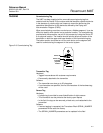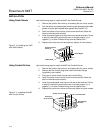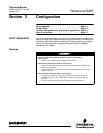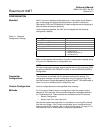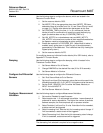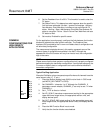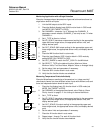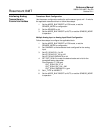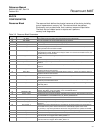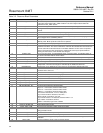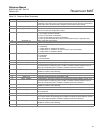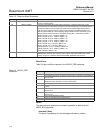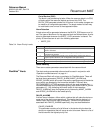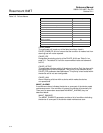
Reference Manual
00809-0100-4697, Rev EA
October 2011
3-7
Rosemount 848T
BLOCK
CONFIGURATION
Resource Block The resource block defines the physical resources of the device including
type of measurement, memory, etc. The resource block also defines
functionality, such as shed times, that is common across multiple blocks.
The block has no linkable inputs or outputs and it performs
memory-level diagnostics.
Table 3-2. Resource Block Parameters
Number Parameter Description
01 ST_REV The revision level of the static data associated with the function block.
02 TAG_DESC The user description of the intended application of the block.
03 STRATEGY The strategy field can be used to identify grouping of blocks.
04 ALERT_KEY The identification number of the plant unit.
05 MODE_BLK The actual, target, permitted, and normal modes of the block. For further description, see the
Mode parameter formal model in FF-890.
06 BLOCK_ERR This parameter reflects the error status associated with the hardware or software components
associated with a block. Multiple errors may be shown. For a list of enumeration values, see
FF-890, Block_Err formal model.
07 RS_STATE State of the function block application state machine. For a list of enumeration values, see
FF-890.
08 TEST_RW Read/write test parameter - used only for conformance testing.
09 DD_RESOURCE String identifying the tag of the resource which contains the Device Description for the
resource.
10 MANUFAC_ID Manufacturer identification number - used by an interface device to locate the DD file for the
resource.
11 DEV_TYPE Manufacturer's model number associated with the resource - used by interface devices to
locate the DD file for the resource.
12 DEV_REV Manufacturer revision number associated with the resource - used by an interface device to
locate the DD file for the resource.
13 DD_REV Revision of the DD associated with the resource - used by the interface device to locate the
DD file for the resource.
14 GRANT_DENY Options for controlling access of host computer and local control panels to operating, tuning
and alarm parameters of the block.
15 HARD_TYPES The types of hardware available as channel numbers. The supported hardware type is:
SCALAR_INPUT
16 RESTART Allows a manual restart to be initiated.
17 FEATURES Used to show supported resource block options. The supported features are: Unicode,
Reports, Soft_Write_Lock, Hard_Write_Lock, and Multi-Bit Alarms.
18 FEATURE_SEL Used to select resource block options.
19 CYCLE_TYPE Identifies the block execution methods available for this resource. The supported cycle types
are: SCHEDULED, and COMPLETION_OF_BLOCK_EXECUTION
20 CYCLE_SEL Used to select the block execution method for this resource.
21 MIN_CYCLE_T Time duration of the shortest cycle interval of which the resource is capable.
22 MEMORY_SIZE Available configuration memory in the empty resource. To be checked before attempting a
download.
23 NV_CYCLE_T Minimum time interval specified by the manufacturer for writing copies of NV parameters to
non-volatile memory. Zero means it will never be automatically copied. At the end of
NV_CYCLE_T, only those parameters which have changed need to be updated in NVRAM.
24 FREE_SPACE Percent of memory available for further configuration. Zero in preconfigured resource.
25 FREE_TIME Percent of the block processing time that is free to process additional blocks.
26 SHED_RCAS Time duration at which to give up on computer writes to function block RCas locations. Shed
from RCas will never happen when SHED_RCAS = 0.
27 SHED_ROUT Time duration at which to give up on computer writes to function block ROut locations. Shed
from ROut will never happen when SHED_ROUT = 0.



